What Is the Ideal Speed to Take a 95 M Radius Curve Banked at a 30.0ã‚â° Angle?
27 5.2 Centripetal Force
Summary
- Summate coefficient of friction on a car tire.
- Calculate ideal speed and bending of a motorcar on a turn.
Whatever forcefulness or combination of forces can crusade a centripetal or radial acceleration. Just a few examples are the tension in the rope on a tether brawl, the force of Earth'due south gravity on the Moon, friction between roller skates and a rink flooring, a banked roadway's force on a machine, and forces on the tube of a spinning centrifuge.
Any cyberspace force causing uniform circular movement is called a centripetal force . The management of a centripetal forcefulness is toward the middle of curvature, the aforementioned as the direction of centripetal dispatch. According to Newton'due south second law of motion, net force is mass times acceleration: net F = ma . For uniform circular motility, the dispatch is the centripetal dispatch— a = a c . Thus, the magnitude of centripetal force F c is
[latex]\boldsymbol{F_{\textbf{c}}=ma_{\textbf{c}}}.[/latex]
By using the expressions for centripetal acceleration a c from [latex]\boldsymbol{a_{\textbf{c}}=\frac{v^2}{r}}[/latex] we get an expression for the centripetal force F c in terms of mass, velocity, and radius of curvature:
[latex]\boldsymbol{F_{\textbf{c}} = \dfrac{mv^2}{r}}[/latex]
The centripetal force F c is always perpendicular to the path and pointing to the center of curvature, because a c is perpendicular to the velocity and pointing to the heart of curvature.
Notation that if y'all solve the first expression for r , you get
[latex]\boldsymbol { r\: = \frac{mv^2} {F_{\textbf{c}} } }.[/latex]
This implies that for a given mass and velocity, a big centripetal force causes a small radius of curvature—that is, a tight curve.
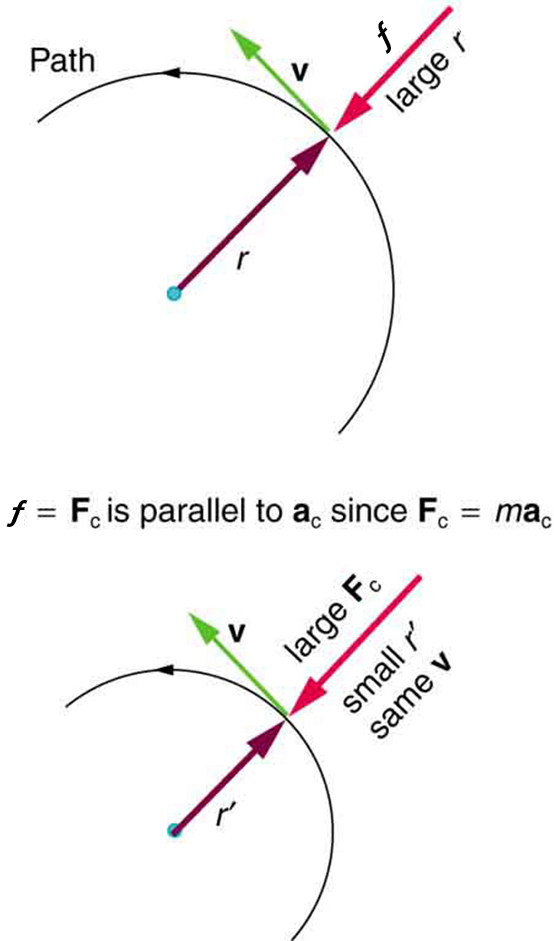
Example i: What Coefficient of Friction Do Care Tires Need on a Flat Curve?
(a) Calculate the centripetal force exerted on a 900 kg car that negotiates a 500 m radius curve at 25.0 m/s.
(b) Assuming an unbanked curve, notice the minimum static coefficient of friction, between the tires and the road, static friction being the reason that keeps the car from slipping (see Figure ii).
Strategy and Solution for (a)
We know that [latex]\boldsymbol{{F}_{\textbf{c}}=\frac{mv^2}{r}}.[/latex] Thus,
[latex]\boldsymbol{ {F}_{\textbf{c}}\:= \frac{mv^2}{r}}= \frac{(900\textbf{ kg})(25.0\textbf{ grand/s})^two}{(500\textbf{ one thousand})} =\:1125\textbf{ N} }.[/latex]
Strategy for (b)
Effigy ii shows the forces interim on the car on an unbanked (level ground) bend. Friction is to the left, keeping the motorcar from slipping, and because it is the merely horizontal forcefulness acting on the machine, the friction is the centripetal forcefulness in this case. We know that the maximum static friction (at which the tires roll but practise not sideslip) is μ s N , where μ s is the static coefficient of friction and N is the normal force. The normal force equals the motorcar'south weight on level basis, so that Northward = mg . Thus the centripetal force in this situation is
[latex]\boldsymbol{F_{\textbf{c}}=f=\mu_{\textbf{due south}}\textbf{Northward}=\mu_{\textbf{due south}}mg}.[/latex]
Now we have a relationship betwixt centripetal force and the coefficient of friction. Using the first expression for F c from the equation
[latex]\brainstorm{array}{c} \boldsymbol{F_{\textbf{c}}=m\frac{v^ii}{r}} \\ \boldsymbol{F_{\textbf{c}}=mr\omega^2} \end{array}[/latex]
[latex]\boldsymbol{m \frac{v^two}{r} = \mu_{\textbf{s}}mg. }[/latex]
We solve this for μ south , noting that mass cancels, and obtain
[latex]\boldsymbol{ \mu_{\textbf{south}}\:= \frac{v^2}{rg}} .[/latex]
Solution for (b)
Substituting the knowns,
[latex]\boldsymbol{ \mu_{\textbf{s}} \: = \frac{(25.0\textbf{ m/s})^2}{(500\textbf{m})(nine.fourscore\textbf{ m/due south}^2) } =\:0.13} .[/latex]
(Because coefficients of friction are judge, the respond is given to only two digits.)
Discussion
The coefficient of friction found in part (b) is much smaller than is typically found betwixt tires and roads. The machine volition still negotiate the bend if the coefficient is greater than 0.13, considering static friction is a responsive force, being able to assume a value less than but no more μ south N . A higher coefficient would besides allow the car to negotiate the curve at a college speed, just if the coefficient of friction is less, the condom speed would be less than 25 grand/s. Note that mass cancels, implying that in this example, it does not matter how heavily loaded the car is to negotiate the plow. Mass cancels considering friction is assumed proportional to the normal force, which in plough is proportional to mass. If the surface of the route were banked, the normal forcefulness would be less every bit will exist discussed beneath.
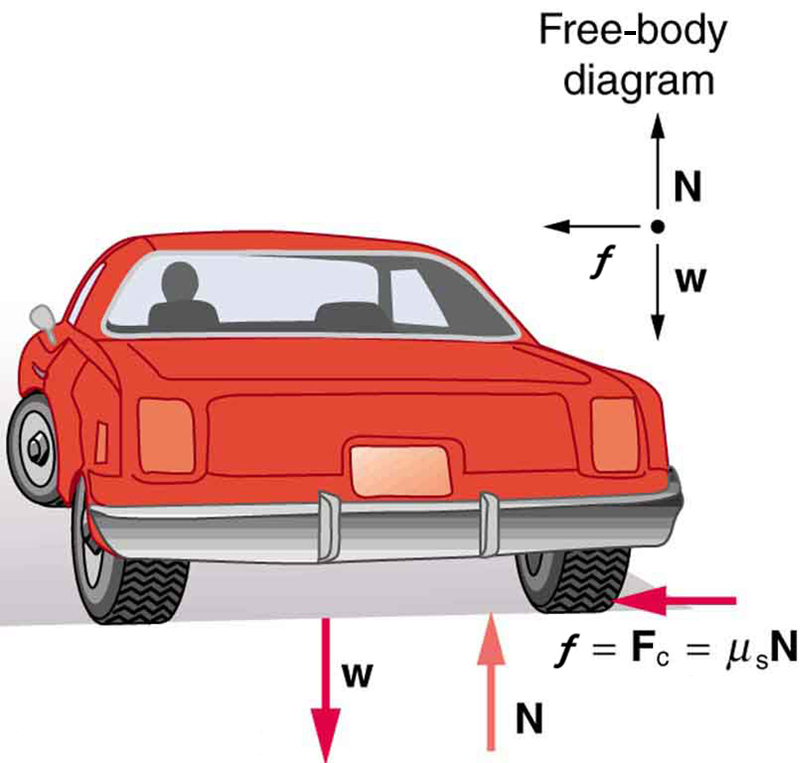
Optional: Banked Curves
Permit us at present consider banked curves , where the gradient of the route helps yous negotiate the bend. Meet Effigy iii. The greater the bending θ , the faster you can take the bend. Race tracks for bikes as well as cars, for example, often have steeply banked curves. In an "ideally banked bend," the angle θ is such that you lot can negotiate the bend at a certain speed without the aid of friction between the tires and the route. We will derive an expression for θ for an ideally banked bend and consider an example related to it.
For ideal banking , the cyberspace external force equals the horizontal centripetal force in the absenteeism of friction. The components of the normal forcefulness N in the horizontal and vertical directions must equal the centripetal force and the weight of the car, respectively. In cases in which forces are non parallel, information technology is most convenient to consider components forth perpendicular axes—in this case, the vertical and horizontal directions.
Figure three shows a free body diagram for a car on a frictionless banked curve. If the angle θ is platonic for the speed and radius, so the net external force will equal the necessary centripetal forcefulness. The only two external forces acting on the auto are its weight westward and the normal force of the road N . (A frictionless surface can but exert a force perpendicular to the surface—that is, a normal force.) These two forces must add to give a cyberspace external force that is horizontal toward the heart of curvature and has magnitude mv 2/r . Because this is the crucial force and it is horizontal, we use a coordinate system with vertical and horizontal axes. Only the normal strength has a horizontal component, and then this must equal the centripetal force—that is,
[latex]\boldsymbol{N\textbf{sin} \;\theta\: = \frac{mv^2}{r} }.[/latex]
Because the machine does not go out the surface of the road, the net vertical force must be aught, meaning that the vertical components of the 2 external forces must be equal in magnitude and opposite in management. From the figure, we run into that the vertical component of the normal strength is N cos θ , and the but other vertical force is the car'due south weight. These must be equal in magnitude; thus,
Due north cos θ = m thou
Now nosotros can combine the last two equations to eliminate N and get an expression for θ , as desired. Solving the second equation for N = mg/(cos θ), and substituting this into the start yields
[latex]\boldsymbol{mg \frac{\textbf{sin} \;\theta}{\textbf{cos} \;\theta}} = \frac{mv^ii}{r}}[/latex]
[latex]\boldsymbol{ mg \;\textbf{tan}(\theta)\:= \frac{mv^two}{r}}[/latex]
[latex]\boldsymbol{\textbf{tan}\theta\:= \frac{v^ii}{rg}.}[/latex]
Taking the inverse tangent gives
[latex]\boldsymbol{\theta=\textbf{tan}^{-one} (\frac{v^2}{rg})}[/latex] (ideally banked curve, no friction).
This expression can be understood by considering how θ depends on five and r . A large θ will exist obtained for a large v and a minor r . That is, roads must be steeply banked for high speeds and sharp curves. Friction helps, because information technology allows you to accept the curve at greater or lower speed than if the curve is frictionless. Note that θ does non depend on the mass of the vehicle.
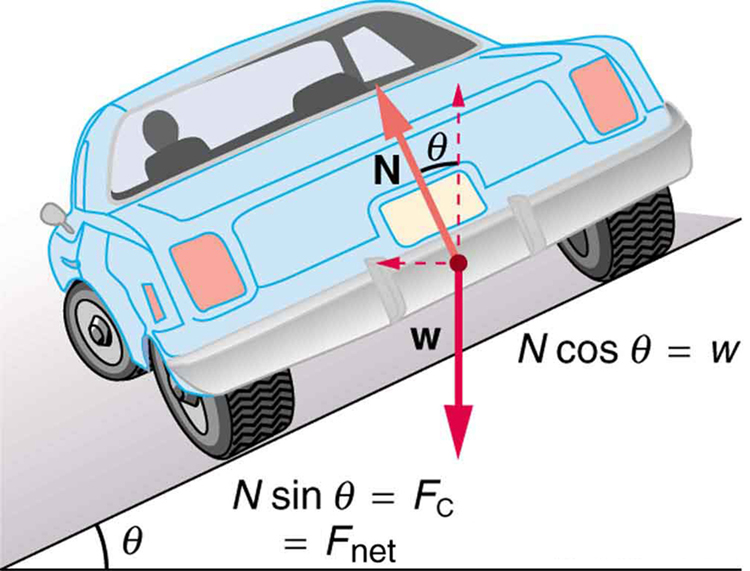
Instance 2: What Is the Ideal Speed to Have a Steeply Banked Tight Bend?
Curves on some test tracks and race courses, such equally the Daytona International Speedway in Florida, are very steeply banked. This cyberbanking, with the aid of tire friction and very stable car configurations, allows the curves to be taken at very high speed. To illustrate, calculate the speed at which a 100 m radius curve banked at 65.0° should exist driven if the road is frictionless.
Strategy
We starting time note that all terms in the expression for the ideal angle of a banked curve except for speed are known; thus, we need only rearrange it and so that speed appears on the left-manus side and then substitute known quantities.
Solution
Starting with
[latex]\boldsymbol{\textbf{tan}\theta\:= \frac{5^2}{rg}}[/latex]
we get
[latex]\boldsymbol{5=(rg\:\textbf{tan}\:\theta)^{i/2}}.[/latex]
Noting that tan 65.0º = 2.14, we obtain
[latex]\begin{array}{lcl} \boldsymbol{5} & = & \boldsymbol{[(100\textbf{ m})(nine.fourscore\textbf{ m/s}^2)(two.fourteen)]^{1/2}} \\ \boldsymbol{} & = & \boldsymbol{45.8}\textbf{ g/s.} \end{array}[/latex]
Word
This is just about 165 km/h, consistent with a very steeply banked and rather sharp bend. Tire friction enables a vehicle to take the curve at significantly college speeds.
Calculations similar to those in the preceding examples can be performed for a host of interesting situations in which centripetal force is involved—a number of these are presented in this affiliate's Problems and Exercises.
TAKE-HOME EXPERIMENT
Enquire a friend or relative to swing a golf club or a tennis racquet. Accept appropriate measurements to gauge the centripetal dispatch of the end of the club or racquet. Yous may cull to practice this in wearisome motion.
PHET EXPLORATIONS: GRAVITY AND ORBITS
Move the lord's day, world, moon and infinite station to come across how it affects their gravitational forces and orbital paths. Visualize the sizes and distances between dissimilar heavenly bodies, and turn off gravity to run into what would happen without it.

Department Summary
- Centripetal force F c is any force causing compatible round motion. It is a "heart-seeking" force that always points toward the center of rotation. It is perpendicular to linear velocity 5 and has magnitude
[latex]\boldsymbol{F_{\textbf{c}}=ma_{\textbf{c}}},[/latex]
which can as well be expressed as
[latex]\boldsymbol{F_{\textbf{c}}=m\frac{v^2}{r}}[/latex]
Conceptual Questions
Conceptual Questions
ane: If you wish to reduce the stress (which is related to centripetal force) on loftier-speed tires, would you use big- or small-diameter tires? Explain.
2: Ascertain centripetal force. Can any type of force (for example, tension, gravitational forcefulness, friction, and so on) exist a centripetal force? Can any combination of forces be a centripetal force?
3: If centripetal force is directed toward the center, why do you lot feel that you are 'thrown' abroad from the eye equally a motorcar goes around a curve? Explain.
iv: Race car drivers routinely cutting corners every bit shown in Figure v. Explain how this allows the curve to be taken at the greatest speed.
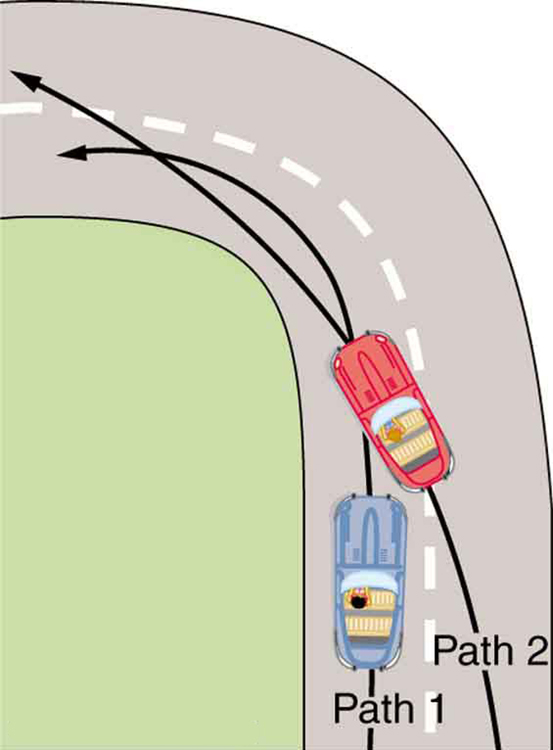
5: A number of amusement parks have rides that brand vertical loops like the 1 shown in Figure half dozen. For safety, the cars are attached to the runway in such a way that they cannot fall off. If the car goes over the pinnacle at merely the correct speed, gravity lone will supply the centripetal force. What other force acts and what is its direction if:
(a) The car goes over the top at faster than this speed?
(b)The car goes over the tiptop at slower than this speed?
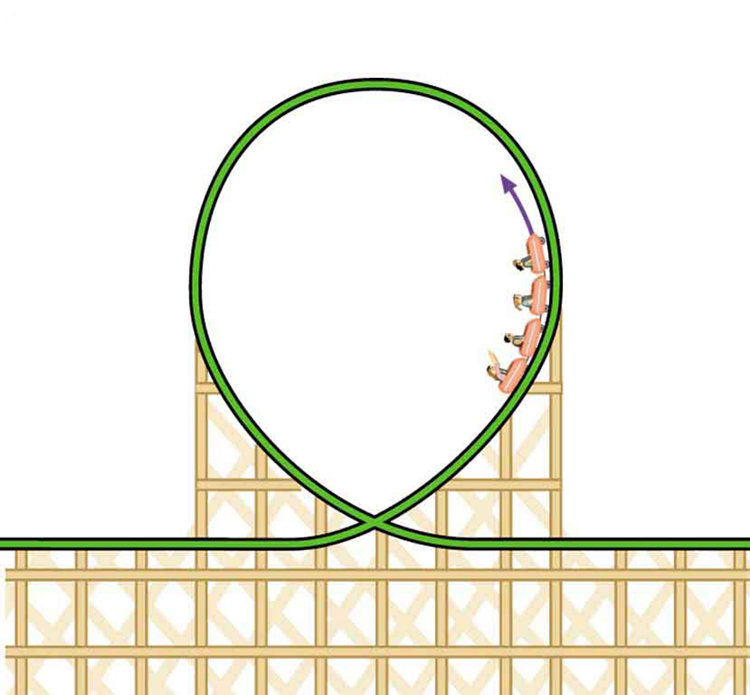
7: What is the direction of the force exerted by the car on the rider as the auto goes over the top of the amusement ride pictured in Figure 6 under the following circumstances:
(a) The auto goes over the top at such a speed that the gravitational forcefulness is the only force acting?
(b) The machine goes over the elevation faster than this speed?
(c) The car goes over the top slower than this speed?
8: As a skater forms a circle, what force is responsible for making her turn? Use a gratis trunk diagram in your respond.
9: Suppose a child is riding on a merry-become-circular at a distance near halfway between its center and edge. She has a lunch box resting on wax paper, so that in that location is very little friction between it and the merry-go-circular. Which path shown in Figure 7 will the dejeuner box take when she lets go? The lunch box leaves a trail in the dust on the merry-go-round. Is that trail direct, curved to the left, or curved to the right? Explain your answer.
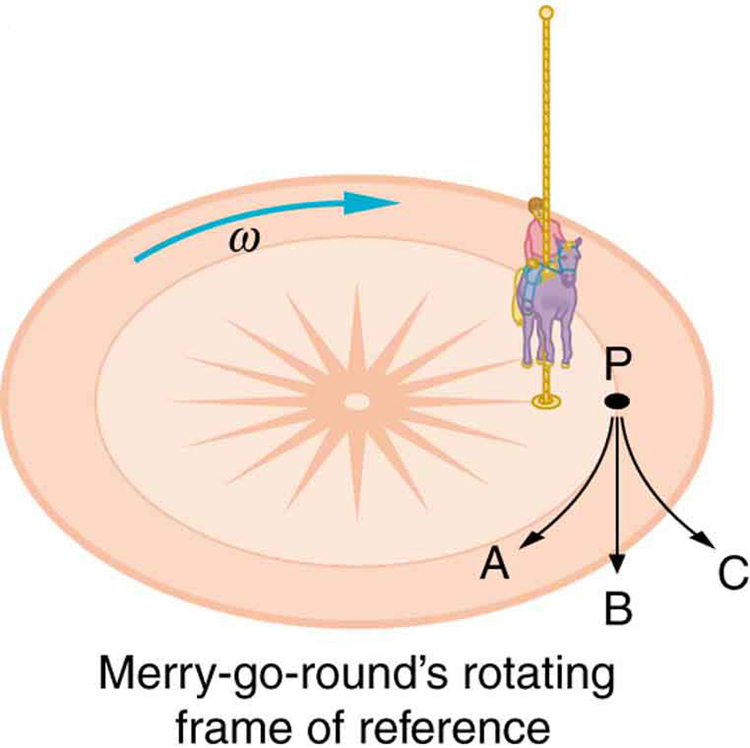
10: Do you feel yourself thrown to either side when y'all negotiate a curve that is ideally banked for your car'south speed? What is the direction of the forcefulness exerted on you by the motorcar seat?
11: Suppose a mass is moving in a round path on a frictionless table as shown in figure. In the Globe'southward frame of reference, in that location is no centrifugal force pulling the mass abroad from the centre of rotation, yet there is a very real forcefulness stretching the string attaching the mass to the nail. Using concepts related to centripetal force and Newton'southward third constabulary, explain what forcefulness stretches the cord, identifying its concrete origin.
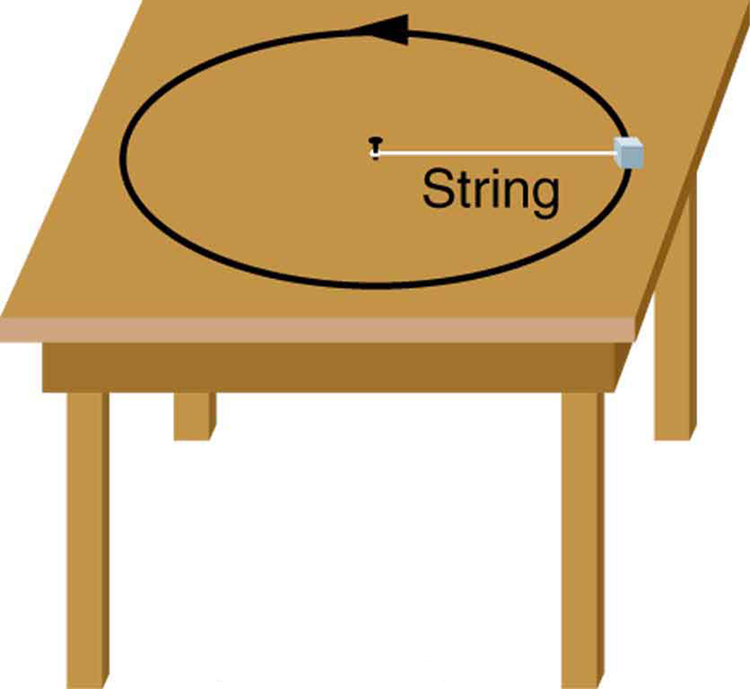
Issues & Exercises
1: A 22.0 kg child is riding a playground merry-go-circular is moving at a speed of 0.0698 m/s when she is 1.25 grand from the center. What is the centripetal force exerted on her? Compare this force to her weight.
ii: What is the ideal banking angle for a gentle turn of i.20 km radius on a highway with a 105 km/h speed limit (about 65 mi/h), assuming everyone travels at the limit?
three: What is the ideal speed to take a 100 m radius bend banked at a twenty.0° angle?
4: (a) What is the radius of a bobsled turn banked at 75.0° and taken at 30.0 g/south, assuming it is ideally banked?
(b) Calculate the centripetal acceleration.
(c) Does this acceleration seem large to you?
5: Part of riding a bike involves leaning at the correct angle when making a plough, as seen in Figure nine. To be stable, the strength exerted by the ground must be on a line going through the center of gravity. The force on the wheel wheel tin can exist resolved into two perpendicular components—friction parallel to the road (this must supply the centripetal force), and the vertical normal force (which must equal the system'southward weight).
(a) Evidence that θ (equally divers in the effigy) is related to the speed v and radius of curvature r of the turn in the same way equally for an ideally banked roadway—that is, θ = tan-1 five 2/rg.
(b) Calculate θ for a 12.0 yard/s turn of radius 30.0 m (as in a race).
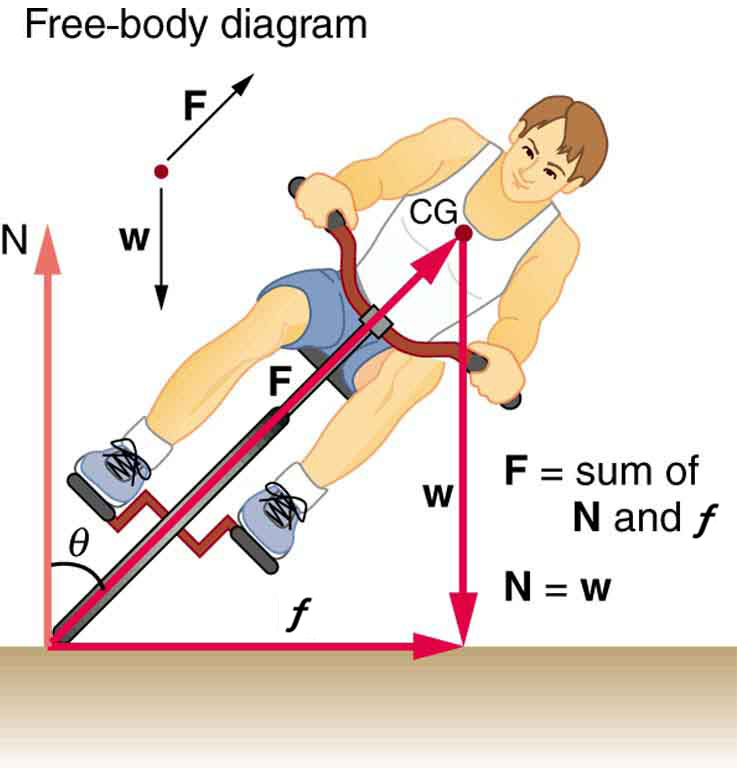
six: Integrated Concepts
If a automobile takes a banked curve at less than the platonic speed, friction is needed to keep it from sliding toward the inside of the bend (a real problem on icy mount roads). (a) Summate the ideal speed to take a 100 m radius curve banked at 15.0º. (b) What is the minimum coefficient of friction needed for a frightened commuter to take the same curve at 20.0 km/h?
7: Modernistic roller coasters take vertical loops like the 1 shown in Effigy 11. The radius of curvature is smaller at the top than on the sides and then that the downward centripetal acceleration at the top will be greater than the acceleration due to gravity, keeping the passengers pressed firmly into their seats. What is the speed of the roller coaster at the acme of the loop if the radius of curvature there is 15.0 m and the downward acceleration of the car is 1.50 g?

eight: Unreasonable Results
(a) Summate the minimum coefficient of friction needed for a car to negotiate an unbanked 50.0 grand radius bend at xxx.0 m/s.
(b) What is unreasonable about the result?
(c) Which bounds are unreasonable or inconsistent?
Glossary
- centripetal forcefulness
- whatever net strength causing uniform circular motion
- ideal cyberbanking
- the sloping of a curve in a road, where the angle of the slope allows the vehicle to negotiate the curve at a certain speed without the assist of friction between the tires and the road; the net external force on the vehicle equals the horizontal centripetal force in the absence of friction
- ideal speed
- the maximum safe speed at which a vehicle tin can turn on a curve without the aid of friction between the tire and the road
- platonic angle
- the angle at which a car can plow safely on a steep curve, which is in proportion to the platonic speed
- banked curve
- the bend in a road that is sloping in a way that helps a vehicle negotiate the curve
Solutions
Problems & Exercises
1: (a) 483 North (b) ii.24 times her weight
2: four.14°
4: 24.vi yard (b) 36.6 m/southwardtwo (c) ac =3.73 g. This does non seem too large, simply it is clear that bobsledders feel a lot of force on them going through sharply banked turns.
half-dozen: (a) 16.2 m/s (b) 0.234
8: (a)one.84 (b) A coefficient of friction this much greater than 1 is unreasonable . (c) The assumed speed is too great for the tight curve.
Source: https://pressbooks.bccampus.ca/douglasphys1108/chapter/5-2-centripetal-force/